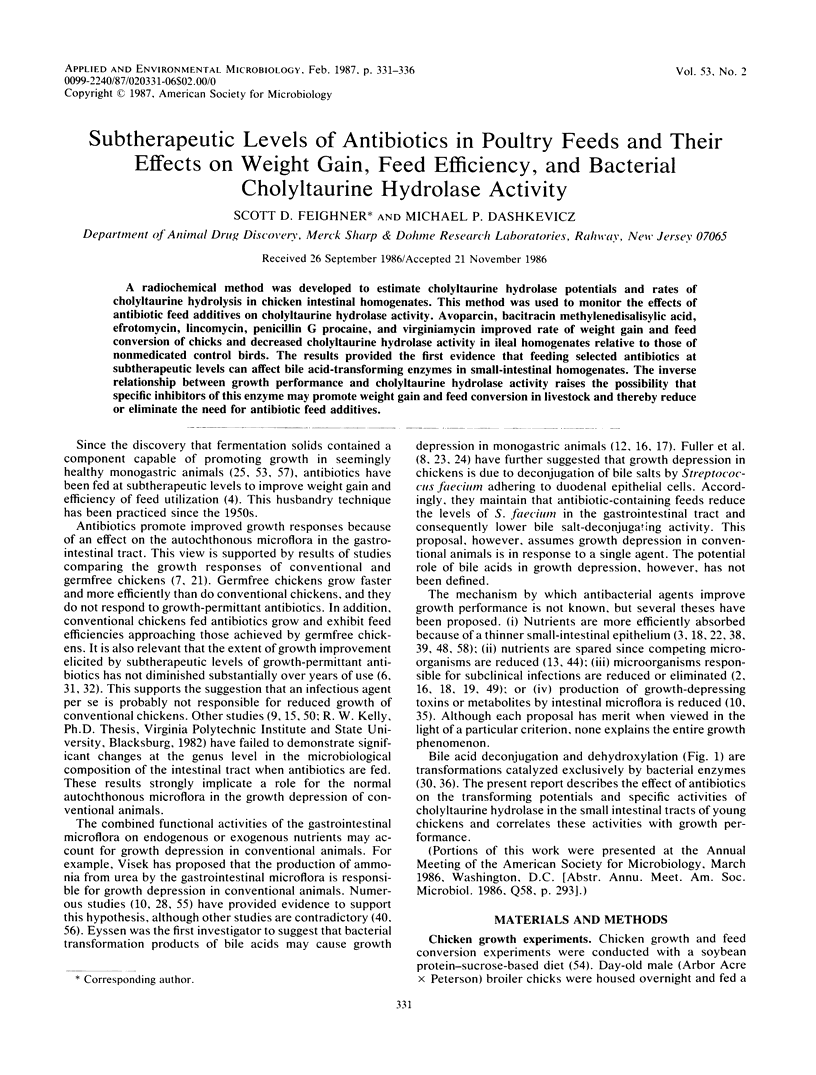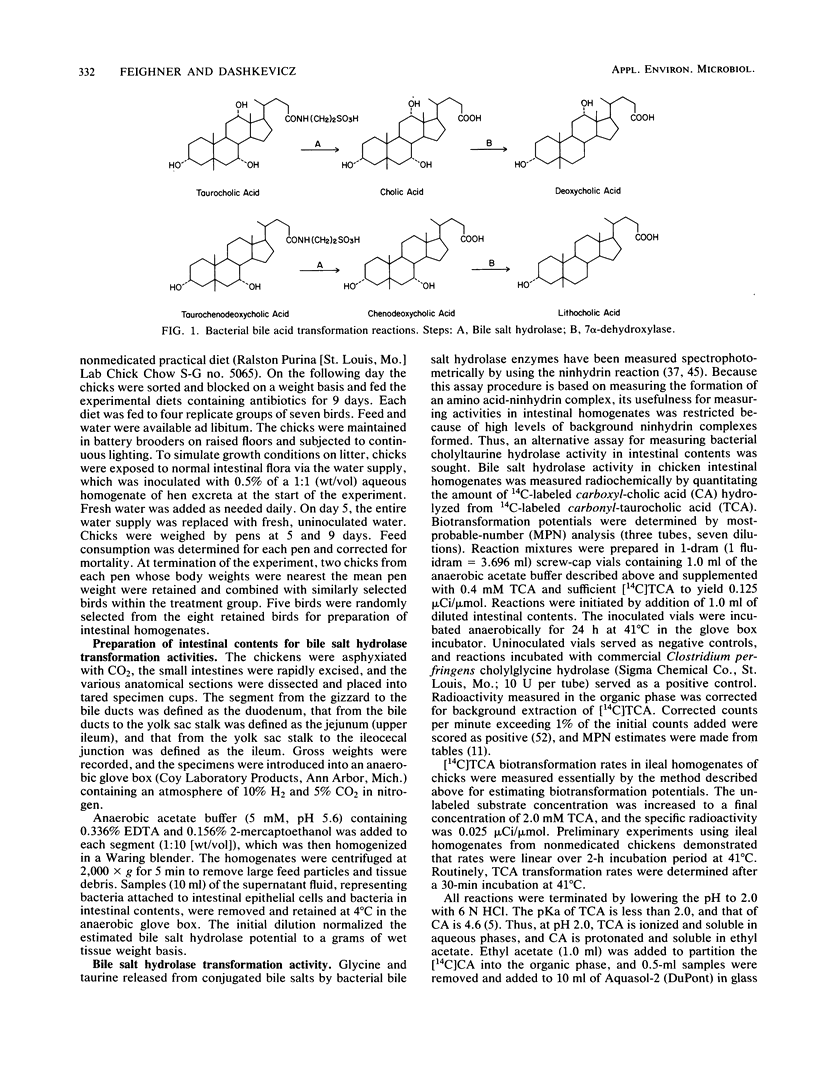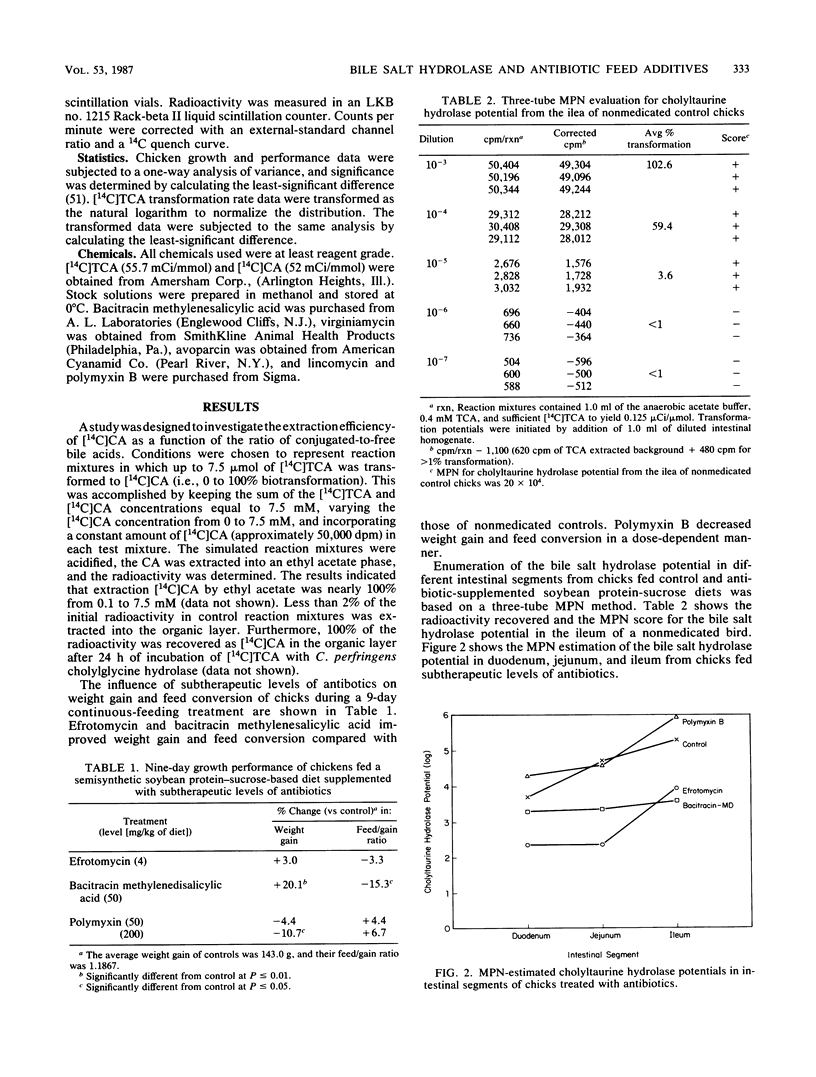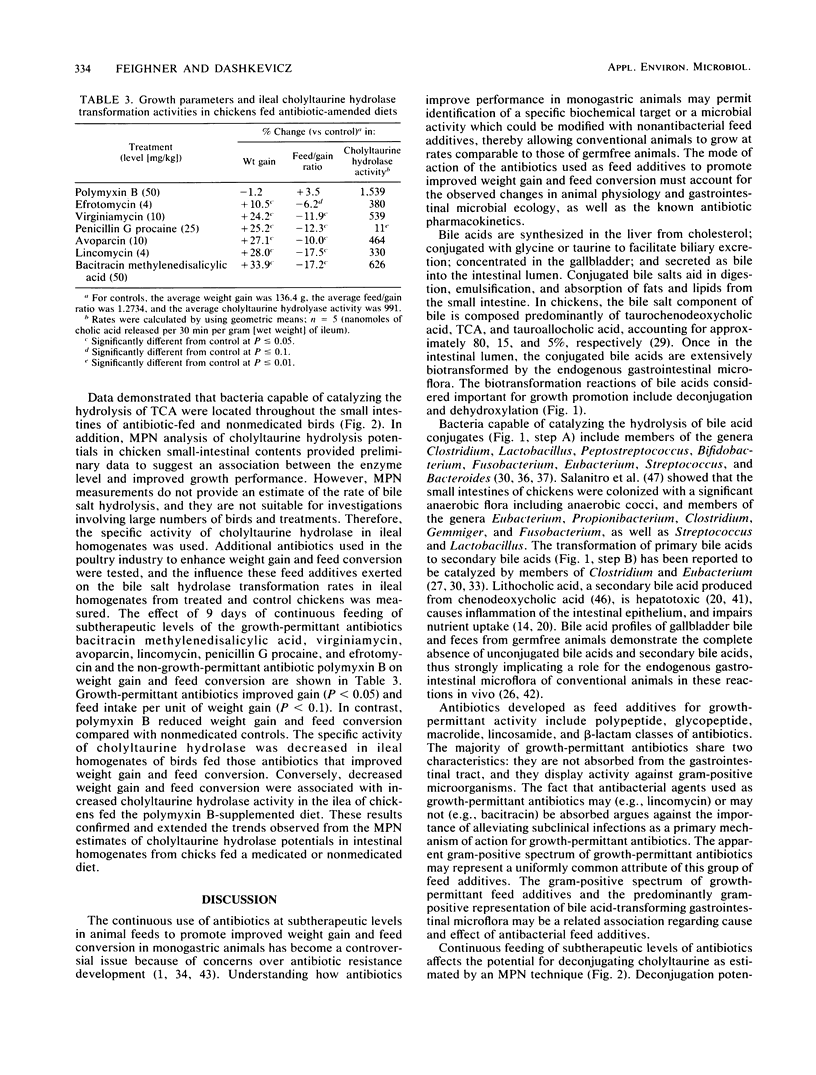Abstract
A radiochemical method was developed to estimate cholyltaurine hydrolase potentials and rates of cholyltaurine hydrolysis in chicken intestinal homogenates. This method was used to monitor the effects of antibiotic feed additives on cholyltaurine hydrolase activity. Avoparcin, bacitracin methylenedisalisylic acid, efrotomycin, lincomycin, penicillin G procaine, and virginiamycin improved rate of weight gain and feed conversion of chicks and decreased cholyltaurine hydrolase activity in ileal homogenates relative to those of nonmedicated control birds. The results provided the first evidence that feeding selected antibiotics at subtherapeutic levels can affect bile acid-transforming enzymes in small-intestinal homogenates. The inverse relationship between growth performance and cholyltaurine hydrolase activity raises the possibility that specific inhibitors of this enzyme may promote weight gain and feed conversion in livestock and thereby reduce or eliminate the need for antibiotic feed additives.
Full text
PDF





Selected References
These references are in PubMed. This may not be the complete list of references from this article.
- Baldwin R. A. The development of transferable drug resistance in Salmonella and its public health implications. J Am Vet Med Assoc. 1970 Dec 1;157(11):1841–1853. [PubMed] [Google Scholar]
- Boyd F. M., Edwards H. M., Jr Fat absorption by germ-free chicks. Poult Sci. 1967 Nov;46(6):1481–1483. doi: 10.3382/ps.0461481. [DOI] [PubMed] [Google Scholar]
- COATES M. E., DAVIES M. K. The effects of continuous administration of penicillin to successive generations of chicks. Br J Nutr. 1959;13(2):205–212. doi: 10.1079/bjn19590027. [DOI] [PubMed] [Google Scholar]
- COATES M. E., FULLER R., HARRISON G. F., LEV M., SUFFOLK S. F. A comparison of the growth of chicks in the Gustafsson germ-free apparatus and in a conventional environment, with and without dietary supplements of penicillin. Br J Nutr. 1963;17:141–150. doi: 10.1079/bjn19630015. [DOI] [PubMed] [Google Scholar]
- Cabral D. J., Hamilton J. A., Small D. M. The ionization behavior of bile acids in different aqueous environments. J Lipid Res. 1986 Mar;27(3):334–343. [PubMed] [Google Scholar]
- Cole C. B., Fuller R. Bile acid deconjugation and attachment of chicken gut bacteria: their possible role in growth depression. Br Poult Sci. 1984 Apr;25(2):227–231. doi: 10.1080/00071668408454861. [DOI] [PubMed] [Google Scholar]
- DANG H. C., VISEK W. J. Effect of urease injection on body weights of growing rats and chicks. Proc Soc Exp Biol Med. 1960 Oct;105:164–167. doi: 10.3181/00379727-105-26046. [DOI] [PubMed] [Google Scholar]
- Eyssen H. Role of the gut microflora in metabolism of lipids and sterols. Proc Nutr Soc. 1973 Sep;32(2):59–63. [PubMed] [Google Scholar]
- Eyssen H., Vandeputte M., Evrard E. Effect of various dietary bile acids on nutrient absorption and on liver size in chicks. Arch Int Pharmacodyn Ther. 1965 Dec;158(2):292–306. [PubMed] [Google Scholar]
- FORBES M., PARK J. T. Growth of germ-free and conventional chicks: effect of diet, dietary penicillin and bacterial environment. J Nutr. 1959 Jan 10;67(1):69–84. doi: 10.1093/jn/67.1.69. [DOI] [PubMed] [Google Scholar]
- Fuller R., Houghton S. B., Coates M. E. The effect of dietary penicillin on the growth of gnotobiotic chickens monoassociated with Streptococcus faecium. Br Poult Sci. 1983 Jan;24(1):111–114. doi: 10.1080/00071668308416719. [DOI] [PubMed] [Google Scholar]
- Gustafsson B. E., Gustafsson J., Carlstedt-Duke B. Prolonged induction of germfree bile acid pattern in conventional rats by antibiotics. Acta Med Scand. 1977;201(3):155–160. doi: 10.1111/j.0954-6820.1977.tb15673.x. [DOI] [PubMed] [Google Scholar]
- Gustafsson B. E., Midtvedt T., Norman A. Isolated fecal microorganisms capable of 7-alpha-dehydroxylating bile acids. J Exp Med. 1966 Feb 1;123(2):413–432. doi: 10.1084/jem.123.2.413. [DOI] [PMC free article] [PubMed] [Google Scholar]
- HARBERS L. H., ALVARES A. P., JACOBSON A. I., VISEK W. J. Effect of barbituric acid and chlortetracycline upon growth, ammonia concentration, and urease activity in the gastrointestinal tract of chicks. J Nutr. 1963 May;80:75–79. doi: 10.1093/jn/80.1.75. [DOI] [PubMed] [Google Scholar]
- HUHTANEN C. N., PENSACK J. M. THE DEVELOPMENT OF THE INTESTINAL FLORA OF THE YOUNG CHICK. Poult Sci. 1965 May;44:825–830. doi: 10.3382/ps.0440825. [DOI] [PubMed] [Google Scholar]
- Haslewood G. A. Bile salts of germ-free domestic fowl and pigs. Biochem J. 1971 Jun;123(1):15–18. doi: 10.1042/bj1230015. [DOI] [PMC free article] [PubMed] [Google Scholar]
- Hirano S., Nakama R., Tamaki M., Masuda N., Oda H. Isolation and characterization of thirteen intestinal microorganisms capable of 7 alpha-dehydroxylating bile acids. Appl Environ Microbiol. 1981 Mar;41(3):737–745. doi: 10.1128/aem.41.3.737-745.1981. [DOI] [PMC free article] [PubMed] [Google Scholar]
- Holmberg S. D., Osterholm M. T., Senger K. A., Cohen M. L. Drug-resistant Salmonella from animals fed antimicrobials. N Engl J Med. 1984 Sep 6;311(10):617–622. doi: 10.1056/NEJM198409063111001. [DOI] [PubMed] [Google Scholar]
- Hylemon P. B., Stellwag E. J. Bile acid biotransformation rates of selected gram-positive and gram-negative intestinal anaerobic bacteria. Biochem Biophys Res Commun. 1976 Apr 19;69(4):1088–1094. doi: 10.1016/0006-291x(76)90484-8. [DOI] [PubMed] [Google Scholar]
- Kawai Y. Depression of intestinal lysosomal beta-glucuronidase and acid phosphatase activities by gastrointestinal microorganisms. Microbiol Immunol. 1980;24(8):753–756. doi: 10.1111/j.1348-0421.1980.tb02877.x. [DOI] [PubMed] [Google Scholar]
- Kawai Y., Morotomi M. Intestinal enzyme activities in germfree, conventional, and gnotobiotic rats associated with indigenous microorganisms. Infect Immun. 1978 Mar;19(3):771–778. doi: 10.1128/iai.19.3.771-778.1978. [DOI] [PMC free article] [PubMed] [Google Scholar]
- MONSON W. J., HARPER A. E., WINJE M. E., ELVEHJEM C. A., RHODES R. A., SARLES W. B. A mechanism of the vitamin-sparing effect of antibiotics. J Nutr. 1954 Apr 10;52(4):627–636. doi: 10.1093/jn/52.4.627. [DOI] [PubMed] [Google Scholar]
- Madsen D. C., Wostmann B. S., Beaver M., Chang L. Effects of Aureomycin on bile acids in rats. J Lab Clin Med. 1978 Apr;91(4):605–611. [PubMed] [Google Scholar]
- Marsik F. J., Parisi J. T., Blenden D. C. Transmissible drug resistance of Escherichia coli and Salmonella from humans, animals, and their rural environments. J Infect Dis. 1975 Sep;132(3):296–302. doi: 10.1093/infdis/132.3.296. [DOI] [PubMed] [Google Scholar]
- Nair P. P., Gordon M., Reback J. The enzymatic cleavage of the carbon-nitrogen bond in 3-alpha, 7-alpha, 12-alpha-trihydroxy-5-beta-cholan-24-oylglycine. J Biol Chem. 1967 Jan 10;242(1):7–11. [PubMed] [Google Scholar]
- SIEBURTH J. M., GUTIERREZ J., McGINNIS J., STERN J. R., SCHNEIDER B. H. Effect of antibiotics on intestinal microflora and on growth of turkeys and pigs. Proc Soc Exp Biol Med. 1951 Jan;76(1):15–18. doi: 10.3181/00379727-76-18375. [DOI] [PubMed] [Google Scholar]
- Salanitro J. P., Blake I. G., Muirehead P. A., Maglio M., Goodman J. R. Bacteria isolated from the duodenum, ileum, and cecum of young chicks. Appl Environ Microbiol. 1978 Apr;35(4):782–790. doi: 10.1128/aem.35.4.782-790.1978. [DOI] [PMC free article] [PubMed] [Google Scholar]
- Siddons R. C., Coates M. E. The influence of the intestinal microflora on disaccharidase activities in the chick. Br J Nutr. 1972 Jan;27(1):101–112. doi: 10.1079/bjn19720074. [DOI] [PubMed] [Google Scholar]
- Somerville C. C., Monti C. A., Spain J. C. Modification of the 14C most-probable-number method for use with nonpolar and volatile substrates. Appl Environ Microbiol. 1985 Mar;49(3):711–713. doi: 10.1128/aem.49.3.711-713.1985. [DOI] [PMC free article] [PubMed] [Google Scholar]
- Stutz M. W., Johnson S. L., Judith F. R., Miller B. M. In vitro and in vivo evaluations of the antibiotic efrotomycin. Poult Sci. 1983 Aug;62(8):1612–1618. doi: 10.3382/ps.0621612. [DOI] [PubMed] [Google Scholar]
- WAGNER G. R., NICHOLS E. L., KOHLMEIER R. H., BALLOUN S. L., HAYS V. W. LACK OF EFFECT OF UREASE INJECTION ON GROWTH RATE AND FEED EFFICIENCY OF CHICKS AND RATS. J Nutr. 1963 Sep;81:30–34. doi: 10.1093/jn/81.1.30. [DOI] [PubMed] [Google Scholar]
- WHITEHILL A. R., OLESON J. J., HUTCHINGS B. L. Stimulatory effect of aureomycin on the growth of chicks. Proc Soc Exp Biol Med. 1950 May;74(1):11–13. doi: 10.3181/00379727-74-17793. [DOI] [PubMed] [Google Scholar]
- Yolton D. P., Savage D. C. Influence of certain indigenous gastrointestinal microorganisms on duodenal alkaline phosphatase in mice. Appl Environ Microbiol. 1976 Jun;31(6):880–888. doi: 10.1128/aem.31.6.880-888.1976. [DOI] [PMC free article] [PubMed] [Google Scholar]


